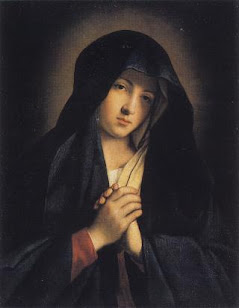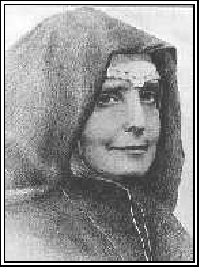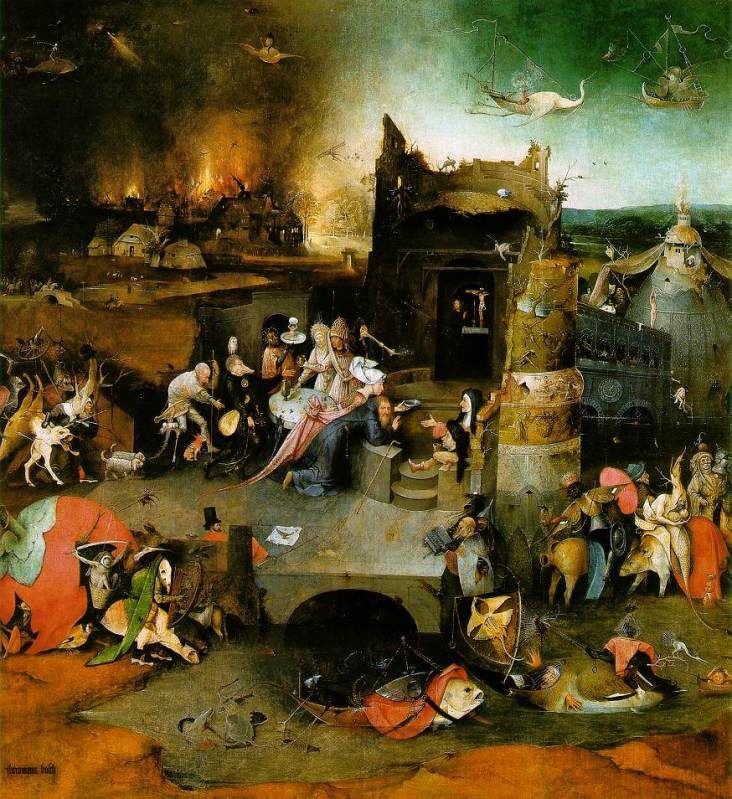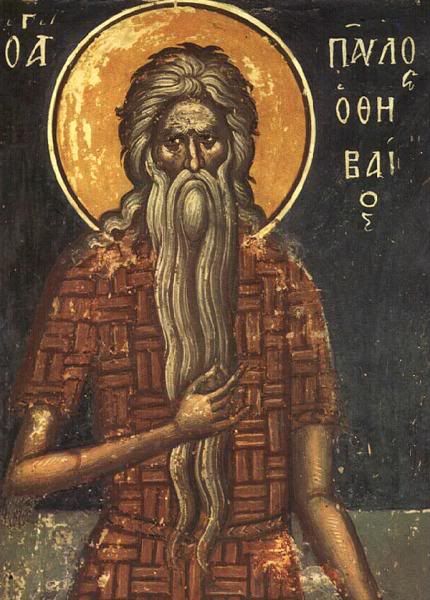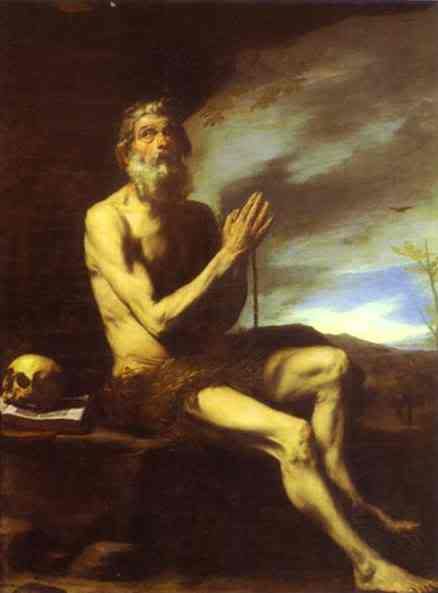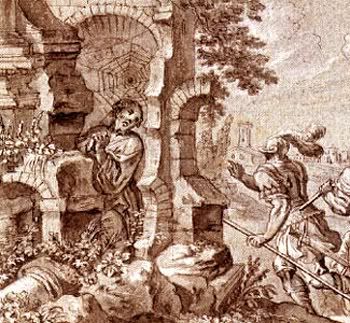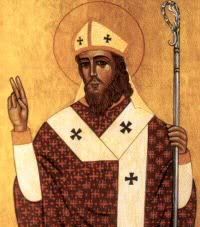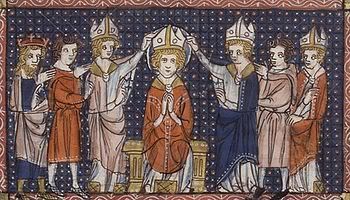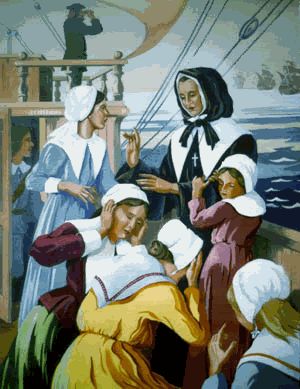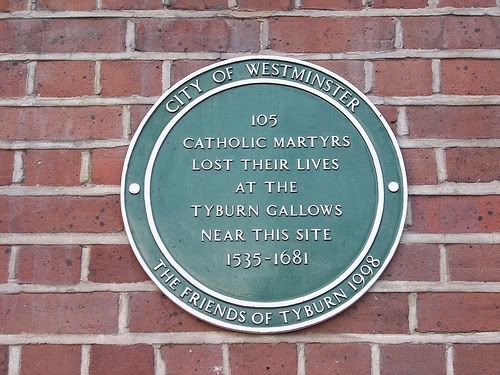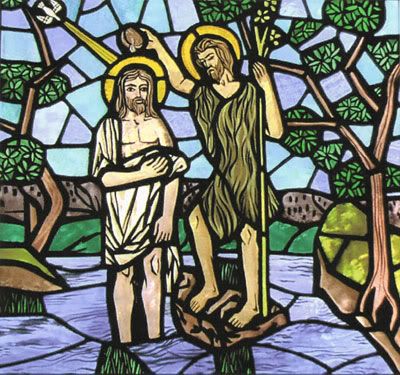Today, January 18, marks the feast day of Saint Vincenza Mary Lopez y Vicuna (1847-1890) of Spain. Born into a wealthy family in the region of Navarre, Saint Vincenza was highly aware of the plight of the region’s poor. She felt strongly called to the service of others, and despite her parents’ objections (and in direct opposition to a marriage that had been arranged for her), Vincenza took a vow of chastity.
Devoted to the Blessed Virgin, Vincenza founded the Daughters of Mary Immaculate, an order which provided protection to the poor women of the area, many of whom worked as domestic servants. She dedicated her life to mothering such poor working girls. In fact, she declared that the work was “a complete delight,” and insisted that she was ready to suffer anything, even death, rather than abandon this calling.
The Daughters of Mary Immaculate lived by the creed: "Steady employment is the safeguard of virtue." Throughout her short life, Saint Vincenza demonstrated this commitment to hard work. Through begging, she raised money to build homes and hostels for working women. But the work was not easy, and Vincenza was ill for much of her life. She died at the young age of 43. In her own words, "I count myself happier in the service of these my sisters, than the great ones of this world in the service of their lords and kings."
Saint Vincenza Mary Lopez y Vicuna is an inspiration to us, a model of social justice and activism which we might strive to emulate in our lives. How many around us are suffering, being taken advantage of, living lives far less worthy of the human dignity each of us possesses? How can we make a difference in these lives? Today, we pray for the commitment to social justice exemplified by Saint Vincenza. We pray for the fire of virtue, and the courage to risk our own comfort to help those around us. Together, we can change the world!
Today concludes my Novena to Our Lady of the Immaculate Conception for the intentions of those who are stuggling to conceive or adopt, are pregnant or expecting children, are new parents, or have suffered pregancy-related loss. I am confident that Our Blessed Mother has heard these intentions and carried them to Our Lord's heart, filled with unlimited love and mercy.
Day 18 of 365
Prayer Intentions: Social Justice in the world; Courage to help those around us who are suffering; Those suffering in the aftermath of the Haitian earthquake
Special Intentions: Those trying to conceive or adopt; Those who are pregnant or expecting children; New parents; Those who have experienced miscarriage or pregnancy complications
Why pray the Rosary every day for a year?
Each time the Blessed Virgin has appeared-- whether it be to Saint Bernadette Soubirous at Lourdes; to Lucia, Jacinta, and Francisco at Fatima; or to Mariette Beco at Banneux-- she has asserted the importance, saving grace, and power of praying the Holy Rosary on a daily basis. Based upon her words, the Rosary is penance and conversion for sinners, a pathway to peace, an end to war, and a powerful act of faith in Jesus Christ. Pope Paul VI presented the Rosary as a powerful means to reach Christ "not merely with Mary but indeed, insofar as this is possible to us, in the same way as Mary, who is certainly the one who thought about Him more than anyone else has ever done."
To show us how this is done, perhaps no one has been more eloquent than the great Cardinal Newman, who wrote: "The great power of the Rosary consists in the fact that it translates the Creed into Prayer. Of course, the Creed is already in a certain sense a prayer and a great act of homage towards God, but the Rosary brings us to meditate again on the great truth of His life and death, and brings this truth close to our hearts. Even Christians, although they know God, usually fear rather than love Him. The strength of the Rosary lies in the particular manner in which it considers these mysteries, since all our thinking about Christ is intertwined with the thought of His Mother, in the relations between Mother and Son; the Holy Family is presented to us, the home in which God lived His infinite love."
As Mary said at Fatima, "Jesus wants to use you to make Me known and loved. He wishes to establish the devotion to My Immaculate Heart throughout the world. I promise salvation to whoever embraces it; these souls will be dear to God, like flowers put by Me to adorn his throne."

The feast day of Saint Anthony of Egypt (251-356), also known as Saint Anthony the Abbot, Saint Anthony the Great, and Anthony of the Desert, is celebrated today. Like Saint Paul the Hermit, who we celebrated last week, Saint Anthony was a man of God, contemplative and ascetic, who preferred solitude and was significantly tested by the Devil. Saint Anthony, often wrongly credited as the first monk, help spread the concepts of acesticism and monasticism by being the first to go into the wilderness (in this case the desert) to contemplate the Lord.
Saint Anthony grew up a wealthy man, and following the deaths of his family at age 20, was moved by the Gospel of Mark: “Go, Sell what you have, and give to the poor” (10:21). Doing just that, Saint Anthony sold his possessions, distributing them to those in need, and wandered into the deep desert to live and pray. He fasted, eating only a small amount of food after nightfall each day, and spent his days in quite contemplation and prayer. Saint Athanasius, who wrote a biography of Saint Anthony detailed that the Devil was so attracted to this prayerful man, he engaged in an all-out fight with him, afflicting him with boredom, apathy, and temptations of the flesh in the form of women. During one of these such temptations, Saint Anthony had a vision that the entire world was full of snares and traps. He cried to the Lord, "Oh good Lord, who may escape from these snares?" A voice said back to him, saying, "humility shall escape them without more." Saint Anthony overcame these temptations through prayer, angering the Devil so greatly that he sent a legion of demons to beat him unconscious. After one particular difficult struggle, Saint Anthony saw a light. Knowing it was God, he called out, "Where were you when I needed you?" and was answered, "I was here. I was watching your struggle. Because you didn't give in, I will stay with you and protect you forever." The villagers who occasionally brought him food found Saint Anthony near death, returning him to the village and offering medical care.
Saint Anthony returned to the wilderness, sealing himself into an abandoned Roman fort, and communicating only through a small crack in the outer wall. Again the Devil tortured him with visions of savage animals, threatening to kill him, but through his deep faith, Saint Anthony prevailed. Never antisocial, Saint Anthony received villagers, offering advice and spiritual guidance in brief words through the crack in the wall, although these faithful were never allowed entrance into his cell. Following 30 years of isolation, Saint Anthony emerged from the fort, and contrary to expectations, was healthy, robust, and spiritually enlightened. He checked on the status of various faith communities, actively opposing the laws of the time by preaching Christian faith.
Saint Anthony returned to the desert, inspiring a monastery and attracting followers. While he lived separately from the community, he instructed the brothers through manual work and prayer. Saint Anthony died at the age of 105, and was buried in an unmarked desert grave. This grave was later discovered and moved a number of times to escape destruction and persecution, ending up in France (Saint-Antoine-en-Dauphiné), and held responsible for a number of miracles, including miraculous cures of skin afflictions known as St. Anthony’s Fire.
Saint Anthony’s temptations inspired a book, an opera, and numerous paintings. In art, Saint Anthony is often depicted with a T-shaped Cross, a book, and a pig. The Cross and book represent his tools to fight the Devil, whereas the pig is thought to represent the Devil. One important painting of Saint Anthony was created by Heironymous Bosch, a Dutch painter in the 14th century. As the website of the WebMuseum, Paris describes:
Bosch's spiritual heroes were the saints who endured both physical and mental torment, yet remained steadfast. Among the saints, Bosch's favorite was Saint Anthony, the subject of his triptych The Temptation of Saint Anthony (c.1500; Museo National de Arte Antiga, Lisbon), which features physical punishment on the left wing, a Black Mass in the center, and the blandishments of food and sex on the right wing. St. Anthony's triumph over such trials is mirrored by those of other hermit saints and by the Passion of Christ, whose arrest and carrying of the cross adorn the exterior of the Lisbon altarpiece.
In Bosch's day, temptation not only had the meaning it has today, but also meant physical/mental assault by demons. So St Anthony is not only tempted by the pleasures of the flesh and so on, he is also beaten up and terrorized by the demons.
Saint Anthony grew up a wealthy man, and following the deaths of his family at age 20, was moved by the Gospel of Mark: “Go, Sell what you have, and give to the poor” (10:21). Doing just that, Saint Anthony sold his possessions, distributing them to those in need, and wandered into the deep desert to live and pray. He fasted, eating only a small amount of food after nightfall each day, and spent his days in quite contemplation and prayer. Saint Athanasius, who wrote a biography of Saint Anthony detailed that the Devil was so attracted to this prayerful man, he engaged in an all-out fight with him, afflicting him with boredom, apathy, and temptations of the flesh in the form of women. During one of these such temptations, Saint Anthony had a vision that the entire world was full of snares and traps. He cried to the Lord, "Oh good Lord, who may escape from these snares?" A voice said back to him, saying, "humility shall escape them without more." Saint Anthony overcame these temptations through prayer, angering the Devil so greatly that he sent a legion of demons to beat him unconscious. After one particular difficult struggle, Saint Anthony saw a light. Knowing it was God, he called out, "Where were you when I needed you?" and was answered, "I was here. I was watching your struggle. Because you didn't give in, I will stay with you and protect you forever." The villagers who occasionally brought him food found Saint Anthony near death, returning him to the village and offering medical care.
Saint Anthony returned to the wilderness, sealing himself into an abandoned Roman fort, and communicating only through a small crack in the outer wall. Again the Devil tortured him with visions of savage animals, threatening to kill him, but through his deep faith, Saint Anthony prevailed. Never antisocial, Saint Anthony received villagers, offering advice and spiritual guidance in brief words through the crack in the wall, although these faithful were never allowed entrance into his cell. Following 30 years of isolation, Saint Anthony emerged from the fort, and contrary to expectations, was healthy, robust, and spiritually enlightened. He checked on the status of various faith communities, actively opposing the laws of the time by preaching Christian faith.
Saint Anthony returned to the desert, inspiring a monastery and attracting followers. While he lived separately from the community, he instructed the brothers through manual work and prayer. Saint Anthony died at the age of 105, and was buried in an unmarked desert grave. This grave was later discovered and moved a number of times to escape destruction and persecution, ending up in France (Saint-Antoine-en-Dauphiné), and held responsible for a number of miracles, including miraculous cures of skin afflictions known as St. Anthony’s Fire.
Saint Anthony’s temptations inspired a book, an opera, and numerous paintings. In art, Saint Anthony is often depicted with a T-shaped Cross, a book, and a pig. The Cross and book represent his tools to fight the Devil, whereas the pig is thought to represent the Devil. One important painting of Saint Anthony was created by Heironymous Bosch, a Dutch painter in the 14th century. As the website of the WebMuseum, Paris describes:
Bosch's spiritual heroes were the saints who endured both physical and mental torment, yet remained steadfast. Among the saints, Bosch's favorite was Saint Anthony, the subject of his triptych The Temptation of Saint Anthony (c.1500; Museo National de Arte Antiga, Lisbon), which features physical punishment on the left wing, a Black Mass in the center, and the blandishments of food and sex on the right wing. St. Anthony's triumph over such trials is mirrored by those of other hermit saints and by the Passion of Christ, whose arrest and carrying of the cross adorn the exterior of the Lisbon altarpiece.
In Bosch's day, temptation not only had the meaning it has today, but also meant physical/mental assault by demons. So St Anthony is not only tempted by the pleasures of the flesh and so on, he is also beaten up and terrorized by the demons.
(click on pictures to enlarge)
Saint Anthony endured significant temptation, anticipating the traps and snares of the Devil, and then relying on God’s love and support to overcome them. His reliance on the Lord, and deep faith in his goodness and protection, allowed Saint Anthony to persevere, even in the most dark and depressing times. How often do we give up, lose hope, and despair in our lot in life? How quickly do we feel abandoned by the Lord? How often do we hear (or say), ‘A loving God wouldn’t let this happen?’ We look to Saint Anthony’s quiet faith as inspiration. Let us know lose faith, but remain strong in the knowledge that our Lord will never abandon us. Let us pray for the intercession of Saint Anthony and our Holy Mother for strength, that we may continue to struggle against the temptations of Satan.
Day 17 of 365
Prayer Intentions: For the strength to resist temptation; For a deepening of faith; Those suffering in the aftermath of the Haitian earthquake
Prayer Requests: For a loved one’s recovery from breast cancer (P); Peace in the life of a son (J); Recovery from surgery (L); For a sick brother (E)
Special Intentions: Those trying to conceive or adopt; Those who are pregnant or expecting children; New parents; Those who have experienced miscarriage or pregnancy complications
Today we review the history of an invocation of Our Blessed Mother, Our Lady of Good Success. The account of this historic visit from Mary begins and Spain, and then takes root in Quito, Ecuador. Today, January 16, is the anniversary of the first apparition in Quito. The second anniversary is marked with a feast day, February 2.
But we begin in Spain, where the first devotion to Our Lady of Good Success was officially recognized in 1606. At that time, two Spanish friars to meet with the Pope Paul V to receive approval for their order, the Order of Saint Francis of Paola. During their travels, they were overtaken by a storm of such magnitude it threatened their lives. Praying in earnest for the Lord’s guidance and assistance, they immediately saw a glowing light emanating from a cave in the cliffs above them. Climbing up, they entered the cave and discovered a beautiful statue of the Blessed Virgin cradling the infant Jesus in her arms. They were surrounded by otherworldly shimmering lights and sweet fragrances. They carried the statue with them to their visit with the pope, hoping the Blessed Mother would facilitate their meeting.
Upon presentation to Pope Paul V, he knelt before the statue and placed his cross around the neck. As he embraced and kissed the statue, he said to the brothers:
“Look Brothers! She is smiling! Why does she smile so? What good success you have had on this journey! There is no doubt that Our Lady has deigned to protect and support you in your work. Therefore it will not be me that will go against Her. May all of your efforts obtain good success!”
Pope Paul V blessed the radiant statue and christened her Our Lady of Good Success. The image was dedicated and displayed in the Royal Hospital of Madrid where it became known for miracles, "for the numerous favors granted by Heaven through her.” . Presently, the statue resides in the Church of Buen Suceso in Madrid.
Quito, Ecuador
Around that same time, five religious sisters of the Order of Our Lady of the Immaculate Conception traveled from Spain to Quito, Ecuador to start the first convent. A young girl, no more than 13, Mariana de Jésus Torres, joined them on the journey as she was planning on joining the Order. Even at a young age, Mariana was recognized as devout, pure, and filled with the grace of God.
When Mariana was approximately eighteen years old, the Blessed Mother appeared to her and asked if she would be willing to offer her life for the sins of the world in the twentieth century -- especially for the sins of blasphemy, heresy and impurity. The shock of the vision of what lied in store for the earth led to Mariana’s death. At that moment, she was given a choice to stay in heaven or return to earth in penance for the world. With the encouragement of Our Blessed Lady, Mariana chose to stay on the earth, becoming an expiatory sacrifice in suffering for the world. Mariana suffered greatly, but willingly did so with patience and resignation.
The Blessed Mother appeared to Mariana a number of times, over the next decade. The most notable of these apparations occurred on February 2 (which I will blog about on February 2, the feast day of Our Lady of Good Success) and January 16.
On January 16, Our Lady of Good Success appeared to Mariana as she was praying in the choir loft of the convent church. Our lady commanded that a statue be made in her likeness stating:
“…now I ask and command you to have a statue to be made for the consolation and preservation of my convent and for those faithful souls of that epoch during which there will be a great devotion to me, for I am the Queen of Heaven under many invocations…With the making of this statue I will favor not only my convent, but also the people of Quito—and all the people throughout the centuries.”
Our Lady of Good Success further told Mother Mariana that the statue she commanded be built would serve the following two purposes:
“First so that men in the future might realize how powerful I am in placating Divine Justice and obtaining mercy and pardon for every sinner who comes to me with a contrite heart. For I am the Mother of Mercy and in me there is only goodness and love… and second, when tribulations of spirit and sufferings of the body oppress them and they seem to be drowning in this bottomless sea let them gaze at my holy image and I will always be there ready to listen to their cries and soothe their pain. Tell them that they should always run to their Mother with confidence and love...”
After years of suffering, and eventual approval from her bishop, Mariana had a stutue commissioned by sculpter Francisco del Castillo, a talented artist and known devotee of the Blessed Mother. The miracle associated with the completion fo this statue will be discussed later.
Throughout the rest of her life, Mariana continued to receive apparitions from Our Lady, many of which contained prophecies of future centuriess, recorded then, and having some true since. The message that consistently was delivered by Our Lady of Great Success to Mariana involved staying true to Christ, dangers of laxity in the church, upholding of virtue, and penance and prayer. She implores us to remain faithful to the church, and pray for church leaders, and not to lose hope when all seemed lost. In her last will and testament, Mariana wrote: “Have recourse to her in all your spiritual and temporal needs. When your souls suffer temptations and are immersed in grief, and if the star of your vocation is hidden by Divine permission from the sight of your soul, turn to her with confidence and say:
‘Star of the stormy sea of my mortal life, may your light shine upon me so that I do not stray from the path that leads me to heaven.’
Thus, Our Lady of Great Success is also known as” Star of the Stormy Sea.”
Mariana predicted her own death, based upon her visitations with the Blessed Virgin. She died peacefully on January 16, 1635, on the anniversary of a visitation. In 1906 during the remodeling of the Convent, the sarcophagus in which she had been buried in 1635 was opened and her body was discovered, whole and incorrupt, and exuding the strong fragrance of lilies. Mother Mariana is today known as the “Lily of Quito” and her body preserved in the lower level of the cloistered Convent.
“Good Success” might be misleading to us, leading us to believe that Our Lady was a means to material or worldly possessions or wealth. This, however, is not the connotation of the name given at the time. The invocation of “good success” refers to the perfect gestational development of Christ in the womb of Mary, from conception to birth. It is likely that this term was originally understood by the faithful as a plea for safe child development and delivery, but was easily extended to the invocation of the Blessed Mother’s mediation and intercession in times of need and at death. As the “Star of the Stormy Sea,” an invocation to the Blessed Mother for safe travels became especially common by sailors. Lastly “good success” speaks of broad protection Mary offers the Church, and of the new era that will come. It is an invocation that relates to the future.
Today, we look to Mother Mariana and her willingness to suffer and offer penance for others. We pray in a special way for the intercessions of Our Lady of Good Success, that we may be willing to suffer, offer penance, and keep the faith of Christ in times that are challenging. We pray, too, for the Church, and for it’s leaders.
I also continue the Novena to Our Lady of the Immaculate Conception, asking for special intercession from Our Lady of Good Success.
Day 16 of 365
Prayer Intentions: Suffering, Penance, Faith, the Church; Those suffering in the aftermath of the Haitian earthquake
Prayer Requests: For a loved one’s recovery from breast cancer (P); Peace in the life of a son (J); For an increased willingness to help others (P);
Special Intentions: Those trying to conceive or adopt; Those who are pregnant or expecting children; New parents; Those who have experienced miscarriage or pregnancy complications
But we begin in Spain, where the first devotion to Our Lady of Good Success was officially recognized in 1606. At that time, two Spanish friars to meet with the Pope Paul V to receive approval for their order, the Order of Saint Francis of Paola. During their travels, they were overtaken by a storm of such magnitude it threatened their lives. Praying in earnest for the Lord’s guidance and assistance, they immediately saw a glowing light emanating from a cave in the cliffs above them. Climbing up, they entered the cave and discovered a beautiful statue of the Blessed Virgin cradling the infant Jesus in her arms. They were surrounded by otherworldly shimmering lights and sweet fragrances. They carried the statue with them to their visit with the pope, hoping the Blessed Mother would facilitate their meeting.
Upon presentation to Pope Paul V, he knelt before the statue and placed his cross around the neck. As he embraced and kissed the statue, he said to the brothers:
“Look Brothers! She is smiling! Why does she smile so? What good success you have had on this journey! There is no doubt that Our Lady has deigned to protect and support you in your work. Therefore it will not be me that will go against Her. May all of your efforts obtain good success!”
Pope Paul V blessed the radiant statue and christened her Our Lady of Good Success. The image was dedicated and displayed in the Royal Hospital of Madrid where it became known for miracles, "for the numerous favors granted by Heaven through her.” . Presently, the statue resides in the Church of Buen Suceso in Madrid.
Quito, Ecuador
Around that same time, five religious sisters of the Order of Our Lady of the Immaculate Conception traveled from Spain to Quito, Ecuador to start the first convent. A young girl, no more than 13, Mariana de Jésus Torres, joined them on the journey as she was planning on joining the Order. Even at a young age, Mariana was recognized as devout, pure, and filled with the grace of God.
When Mariana was approximately eighteen years old, the Blessed Mother appeared to her and asked if she would be willing to offer her life for the sins of the world in the twentieth century -- especially for the sins of blasphemy, heresy and impurity. The shock of the vision of what lied in store for the earth led to Mariana’s death. At that moment, she was given a choice to stay in heaven or return to earth in penance for the world. With the encouragement of Our Blessed Lady, Mariana chose to stay on the earth, becoming an expiatory sacrifice in suffering for the world. Mariana suffered greatly, but willingly did so with patience and resignation.
The Blessed Mother appeared to Mariana a number of times, over the next decade. The most notable of these apparations occurred on February 2 (which I will blog about on February 2, the feast day of Our Lady of Good Success) and January 16.
On January 16, Our Lady of Good Success appeared to Mariana as she was praying in the choir loft of the convent church. Our lady commanded that a statue be made in her likeness stating:
“…now I ask and command you to have a statue to be made for the consolation and preservation of my convent and for those faithful souls of that epoch during which there will be a great devotion to me, for I am the Queen of Heaven under many invocations…With the making of this statue I will favor not only my convent, but also the people of Quito—and all the people throughout the centuries.”
Our Lady of Good Success further told Mother Mariana that the statue she commanded be built would serve the following two purposes:
“First so that men in the future might realize how powerful I am in placating Divine Justice and obtaining mercy and pardon for every sinner who comes to me with a contrite heart. For I am the Mother of Mercy and in me there is only goodness and love… and second, when tribulations of spirit and sufferings of the body oppress them and they seem to be drowning in this bottomless sea let them gaze at my holy image and I will always be there ready to listen to their cries and soothe their pain. Tell them that they should always run to their Mother with confidence and love...”
After years of suffering, and eventual approval from her bishop, Mariana had a stutue commissioned by sculpter Francisco del Castillo, a talented artist and known devotee of the Blessed Mother. The miracle associated with the completion fo this statue will be discussed later.
Throughout the rest of her life, Mariana continued to receive apparitions from Our Lady, many of which contained prophecies of future centuriess, recorded then, and having some true since. The message that consistently was delivered by Our Lady of Great Success to Mariana involved staying true to Christ, dangers of laxity in the church, upholding of virtue, and penance and prayer. She implores us to remain faithful to the church, and pray for church leaders, and not to lose hope when all seemed lost. In her last will and testament, Mariana wrote: “Have recourse to her in all your spiritual and temporal needs. When your souls suffer temptations and are immersed in grief, and if the star of your vocation is hidden by Divine permission from the sight of your soul, turn to her with confidence and say:
‘Star of the stormy sea of my mortal life, may your light shine upon me so that I do not stray from the path that leads me to heaven.’
Thus, Our Lady of Great Success is also known as” Star of the Stormy Sea.”
Mariana predicted her own death, based upon her visitations with the Blessed Virgin. She died peacefully on January 16, 1635, on the anniversary of a visitation. In 1906 during the remodeling of the Convent, the sarcophagus in which she had been buried in 1635 was opened and her body was discovered, whole and incorrupt, and exuding the strong fragrance of lilies. Mother Mariana is today known as the “Lily of Quito” and her body preserved in the lower level of the cloistered Convent.
“Good Success” might be misleading to us, leading us to believe that Our Lady was a means to material or worldly possessions or wealth. This, however, is not the connotation of the name given at the time. The invocation of “good success” refers to the perfect gestational development of Christ in the womb of Mary, from conception to birth. It is likely that this term was originally understood by the faithful as a plea for safe child development and delivery, but was easily extended to the invocation of the Blessed Mother’s mediation and intercession in times of need and at death. As the “Star of the Stormy Sea,” an invocation to the Blessed Mother for safe travels became especially common by sailors. Lastly “good success” speaks of broad protection Mary offers the Church, and of the new era that will come. It is an invocation that relates to the future.
Today, we look to Mother Mariana and her willingness to suffer and offer penance for others. We pray in a special way for the intercessions of Our Lady of Good Success, that we may be willing to suffer, offer penance, and keep the faith of Christ in times that are challenging. We pray, too, for the Church, and for it’s leaders.
I also continue the Novena to Our Lady of the Immaculate Conception, asking for special intercession from Our Lady of Good Success.
Day 16 of 365
Prayer Intentions: Suffering, Penance, Faith, the Church; Those suffering in the aftermath of the Haitian earthquake
Prayer Requests: For a loved one’s recovery from breast cancer (P); Peace in the life of a son (J); For an increased willingness to help others (P);
Special Intentions: Those trying to conceive or adopt; Those who are pregnant or expecting children; New parents; Those who have experienced miscarriage or pregnancy complications
The feast day of Saint Paul the Hermit (229-342) is celebrated today. Saint Paul was born in lower Egypt, near Thebes. Orphaned at fifteen, and having survived the persecution of the Church by Emperor Decius, Paul gave up his possessions at age 22 and escaped to the desert. It is here that Paul, the First Hermit, lived for the remainder of his long life in solitude and heavenly contemplation. Despite isolating himself from the world to grow closer to God, Saint Paul continued to pray for the world, praying that it would grow more holy.
Upon arriving in the desert, Saint Paul settled in a cave, near a freshly flowing stream and a single palm tree. The stream provided his water and the tree his food for the first 21 years of his contemplative life. Neither having seen nor talked to anyone during that time, a raven began visiting Saint Paul each day, bringing him a half loaf of bread. Saint Paul subsisted on this meager ration his entire life.
Near the end of his life, Saint Paul’s solitude was interrupted by a visit from Saint Anthony, who in vain thought sought him out to prove that he had served God in the wilderness longer. Upon meeting Saint Paul, Saint Anthony attested to the fact that Paul was a more perfect man than he. The two conversed, with the raven delivering an entire loaf of bread that day.
Saint Anthony returned to bury Saint Paul upon his death, at the urging of then bishop (and now saint) Athanasius. Upon arrival to bury him, Saint Anthony reportedly found a grave freshly dug by a pair of lions. Saint Paul was buried, wrapped in the bishop’s cloak, at the advanced age of 113. The events of his life were later recorded by Saint Jerome.
Saint Paul the Hermit sought communion with the Lord through quiet thought, prayer, and contemplation. By shutting out the noise and distraction of society, he was able to discover the Lord’s blessings more fully in his life. While we may view Saint Paul’s lifestyle as “drastic,” we might also take a lesson from him regarding the importance of quiet space and contemplation. Are we too busy to stop, be still, and in the silence find our Lord? Even when we try, are we able to “turn off” our minds, forget about the annoyances and worries of the day, and focus on Jesus, our savior? Saint Paul inspires us to take time out of our busy lives to sit quietly in prayer and listen for the voice of God.
Day 15 of 365
Prayer Intentions: Stillness within us to commune with God; Those suffering in the aftermath of the Haitian earthquake
Prayer Requests: Friend undergoing kidney transplant and dialysis (L); Continued employment for those who are at risk of job loss (J)
Special Intentions: Those trying to conceive or adopt; Those who are pregnant or expecting children; New parents; Those who have experienced miscarriage or pregnancy complications
Today, January 14, marks the death and martyrdom of Saint Felix of Nola (born early third century, died 255). Born in Campania, Italy, Felix joined the clergy, giving all he had to the poor, shortly following the death of his father. Working under the guidance of Bishop Maximus of Nola, both underwent persecution and torture at the hands of Roman Emperor Decius.
Shortly following the imprisonment of Bishop Maximus, Felix was taken into custody by Roman soldiers, imprisoned, scourged and tortured, and wrapped with heavy chains in his prison cell. He miraculously escaped from his cell, following visitation from an angel who instructed him to go to the aid of his ailing bishop. As the angel encouraged Felix, his chains fell off and his prison cell was opened. Felix rescued Maximus, bearing him on his back (despite weakness and small stature), and effectively hiding both men from Roman authorities until the end of Decius’ reign.
The second attempt to imprison Felix and Maximus was miraculously prevented by a spider! Upon hearing Roman soldiers approaching, Felix crawled into a small hole in the building he was staying, where it is said a spider immediately spun a web over the opening. The guards saw the spider web and ceased searching for the men, assuming that the room had been undisturbed for some time.
Felix was a humble and giving servant of the Lord. Following the death of Maximus, he was called to be the next Bishop of Nola, but refused, indicating that one of his more experienced brothers (ordained only seven days prior to Felix) was more deserving. He refused to reclaim his possessions and land seized during the persecution, instead renting a meager plot, tilling it by hand, and sharing his goods with the poorest around him. It is said that whatever Felix possessed, he gave away to those in need, oftentimes to his own detriment. He died in 255, and is considered a Church martyr due to the torture, imprisonment, persecution, and suffering he endured for his faith. Buried in Nola, numerous miracles have been reported at his tomb.
Felix received a clear call to action from the angel in his prison cell, just as the Blessed Virgin received the Archangel Gabriel’s message of her extraordinary role in the Incarnation of Jesus. Felix heard the call, and risked his life and unimaginable suffering to answer it. While the messages we receive from the Lord are not always heralded by angels, we still need to listen for them—and perhaps listen all the more closely. These are the quiet urgings of our hearts, which bring us closer to our God. How often are we too busy and too wrapped up in our wants and needless anxieties to hear the call of God? Might slowing down and creating some silence in our lives enable a deeper communion with Christ? Today, we pray for that silence—the silence in which we hear and understand what the Lord wishes for us, and the courage to stand up and put the call into action!
Day 14 of 365
Prayer Intentions: Ears with which to hear the message of God; Courage to put it into action
Prayer Requests: Friend suffering with cancer (D); Continued employment for those who are at risk of job loss (A)
Special Intentions: Those trying to conceive or adopt; Those who are pregnant or expecting children; New parents; Those who have experienced miscarriage or pregnancy complications
Shortly following the imprisonment of Bishop Maximus, Felix was taken into custody by Roman soldiers, imprisoned, scourged and tortured, and wrapped with heavy chains in his prison cell. He miraculously escaped from his cell, following visitation from an angel who instructed him to go to the aid of his ailing bishop. As the angel encouraged Felix, his chains fell off and his prison cell was opened. Felix rescued Maximus, bearing him on his back (despite weakness and small stature), and effectively hiding both men from Roman authorities until the end of Decius’ reign.
The second attempt to imprison Felix and Maximus was miraculously prevented by a spider! Upon hearing Roman soldiers approaching, Felix crawled into a small hole in the building he was staying, where it is said a spider immediately spun a web over the opening. The guards saw the spider web and ceased searching for the men, assuming that the room had been undisturbed for some time.
Felix was a humble and giving servant of the Lord. Following the death of Maximus, he was called to be the next Bishop of Nola, but refused, indicating that one of his more experienced brothers (ordained only seven days prior to Felix) was more deserving. He refused to reclaim his possessions and land seized during the persecution, instead renting a meager plot, tilling it by hand, and sharing his goods with the poorest around him. It is said that whatever Felix possessed, he gave away to those in need, oftentimes to his own detriment. He died in 255, and is considered a Church martyr due to the torture, imprisonment, persecution, and suffering he endured for his faith. Buried in Nola, numerous miracles have been reported at his tomb.
Felix received a clear call to action from the angel in his prison cell, just as the Blessed Virgin received the Archangel Gabriel’s message of her extraordinary role in the Incarnation of Jesus. Felix heard the call, and risked his life and unimaginable suffering to answer it. While the messages we receive from the Lord are not always heralded by angels, we still need to listen for them—and perhaps listen all the more closely. These are the quiet urgings of our hearts, which bring us closer to our God. How often are we too busy and too wrapped up in our wants and needless anxieties to hear the call of God? Might slowing down and creating some silence in our lives enable a deeper communion with Christ? Today, we pray for that silence—the silence in which we hear and understand what the Lord wishes for us, and the courage to stand up and put the call into action!
Day 14 of 365
Prayer Intentions: Ears with which to hear the message of God; Courage to put it into action
Prayer Requests: Friend suffering with cancer (D); Continued employment for those who are at risk of job loss (A)
Special Intentions: Those trying to conceive or adopt; Those who are pregnant or expecting children; New parents; Those who have experienced miscarriage or pregnancy complications
Today, January 13, marks the memorial of Saint Hilary of Poiters (A.D. 368), Church bishop and doctor. Known as a staunch defender of the faith, Saint Hilary suffered persecution and exile for asserting the truth of the divinity of Jesus. At that time, the early church was undergoing attack from outside, but also from within in the form of heresy. Even church leaders asserted mistruths about the faith in efforts to justify allegiances to powerful governments or lapses in their own lives. Saint Hilary orthodoxy and public defense of the faith led to exile on the coast of then, Phyrgia (now Turkey). While in exile he penned a 12 volume set of books devoted to exploration of the divinity of Christ and the Holy Trinity.
Throughout his life, in the midst of strife, Saint Hilary fought to speak and write the truth. He facilitated meetings and discussions amongst the various rifts in the church at the time, counseling patience and understanding, while never compromising the tenets of the faith. A favorite motto of St. Hilary was, Ministros veritatis decet vera proferre, "Servants of the truth ought speak the truth."
Speaking the truth is rarely easy when it comes to our Christian beliefs. Many would choose not to hear it, which oftentimes makes us reluctant—whether we are afraid of argument, condemntation, mockery, or just seeming foolish. How often do we discount, deny, or modify the truth of Christ to be more accepted in today’s society? Saint Hilary stands as an example to us—he lost his home, his family (he was bishop prior to church doctrine on celibacy of priests and bishops), his freedom because he refused to back down from preaching the truth of the Gospel. Today, I continue to pray for those who are fearful and afraid, as well as the courage to be truthful.
Today is the fourth day of my Novena to Our Lady of the Immaculate Conception, for the intentions of those trying to conceive or adopt, who are pregnant or expecting children, new parents, and those who have experienced miscarriage or pregnancy complications.
Requested prayers today include recovery for a friend suffering from cancer (D), safe recovery for those undergoing surgery (L), and for the success of the Rosaries for Bishops campaign (S).
Day 13 of 365
Prayer Intentions: Those who live in fear; The times when we are afraid; The courage to be truthful
Prayer Requests: Friend suffering with cancer (D); Success of the Rosaries for Bishops campaign; Recovery from illness (L)
Special Intentions: Those trying to conceive or adopt; Those who are pregnant or expecting children; New parents; Those who have experienced miscarriage or pregnancy complications
Throughout his life, in the midst of strife, Saint Hilary fought to speak and write the truth. He facilitated meetings and discussions amongst the various rifts in the church at the time, counseling patience and understanding, while never compromising the tenets of the faith. A favorite motto of St. Hilary was, Ministros veritatis decet vera proferre, "Servants of the truth ought speak the truth."
Speaking the truth is rarely easy when it comes to our Christian beliefs. Many would choose not to hear it, which oftentimes makes us reluctant—whether we are afraid of argument, condemntation, mockery, or just seeming foolish. How often do we discount, deny, or modify the truth of Christ to be more accepted in today’s society? Saint Hilary stands as an example to us—he lost his home, his family (he was bishop prior to church doctrine on celibacy of priests and bishops), his freedom because he refused to back down from preaching the truth of the Gospel. Today, I continue to pray for those who are fearful and afraid, as well as the courage to be truthful.
Today is the fourth day of my Novena to Our Lady of the Immaculate Conception, for the intentions of those trying to conceive or adopt, who are pregnant or expecting children, new parents, and those who have experienced miscarriage or pregnancy complications.
Requested prayers today include recovery for a friend suffering from cancer (D), safe recovery for those undergoing surgery (L), and for the success of the Rosaries for Bishops campaign (S).
Day 13 of 365
Prayer Intentions: Those who live in fear; The times when we are afraid; The courage to be truthful
Prayer Requests: Friend suffering with cancer (D); Success of the Rosaries for Bishops campaign; Recovery from illness (L)
Special Intentions: Those trying to conceive or adopt; Those who are pregnant or expecting children; New parents; Those who have experienced miscarriage or pregnancy complications
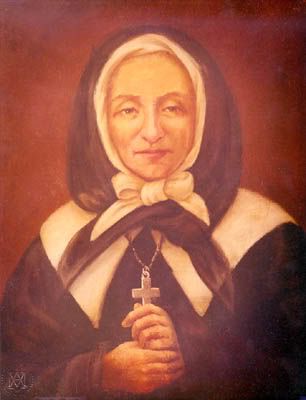 Today marks the feast day and anniversary of the death of Saint Marguerite Bourgeoys (1620-1700), a native of France who, based upon her devotion to the Blessed Virgin, gave up her inheritence and traveled to Canada as a young woman. Marguerite strongly felt the Lord’s call, battling against adversity both from within the Church and without. She survived several outbreaks of plague while traveling to the “New World,” a fire which consumed her village, several attacks by Native American Iriquois Indians, poverty, hunger, and the hardships associated with settling the isolated outpost which would become modern-day Montreal.
Today marks the feast day and anniversary of the death of Saint Marguerite Bourgeoys (1620-1700), a native of France who, based upon her devotion to the Blessed Virgin, gave up her inheritence and traveled to Canada as a young woman. Marguerite strongly felt the Lord’s call, battling against adversity both from within the Church and without. She survived several outbreaks of plague while traveling to the “New World,” a fire which consumed her village, several attacks by Native American Iriquois Indians, poverty, hunger, and the hardships associated with settling the isolated outpost which would become modern-day Montreal. Following her arrival in Canada, Saint Marguerite worked tirelessly to improve health care and education for the settlers—French, Canadian,and Iriquois alike. She founded a school, began the construction of the Notre Dame de Bon Secours chapel in honor of Our Lady of Perpetual Help, and founded the first Canadian religious order for women, the Sisters of the Congregation of Notre Dame. Despite her bishop’s urgings, and eventual orders to remain cloistered, Marguerite and her growing community braved the harsh and dangerous wilderness, teaching and ministering to settlers, the sick, and the poor, eventually convincing Church authorities that they were of more service to God in their present arrangements than they would be cloistered. Her bishop is reported to have said, “I cannot doubt, Mother Bourgeoys, that you will succeed in moving heaven and earth as you have moved me!"
The congregation and religious order that Saint Marguerite established soon grew to over two hundred. By that time, she had become ill and too weak to act as master of the order. She devoted the last years of her life to recording her biography and prayer. Shortly before her death, as one of her young sisters lay critically ill, Saint Marguerite prayed that God would take her life, instead of her sisters. Miraculously, the following morning, the young sister was fully recovered, but Marguerite was struck with a raging fever, from which she never recovered.
Today, the Sisters of the Congregation of Notre Dame number in the thousands, working to promote health, education, and family around the world—in Canada, the United States, Japan, Cameroon, Latin America, and France.
Saint Marguerite was an incredibly brave woman, dedicated to the Holy Mother, and committed to serving the Lord. She put herself at daily risk to deliver the news of God, and minister to the poor and sick. She changed the role of women in new world churches from cloistered to active leaders, earning her the title, “Mother of the Colony.” How often do we fail to listen to what is asked of us because we are afraid, or feel we may look foolish? How quickly do we forget that our Lord will keep us safe? Today we pray for the fire and courage of the Holy Spirit—like that experienced by the disciples on Pentecost—and like that so embodied by Saint Marguerite. We pray for those who live in fear.
Today I continue my Novena to Our Lady of the Immaculate Conception, for the intentions of many, listed below. Also, requested prayers today include peace and hope for those suffering financial hardship (A), safe recovery for those undergoing surgery (L), and relief and cure for those afflicted with cancer.
Day 12 of 365
Prayer Intentions: Those who live in fear; The times when we are afraid
Prayer Requests: Those in financial hardship (A); Safe recovery for those undergoing surgery (L); Relief and cure for those afflicted with cancer.
Special Intentions: Those trying to conceive or adopt; Those who are pregnant or expecting children; New parents; Those who have experienced miscarriage or pregnancy complications
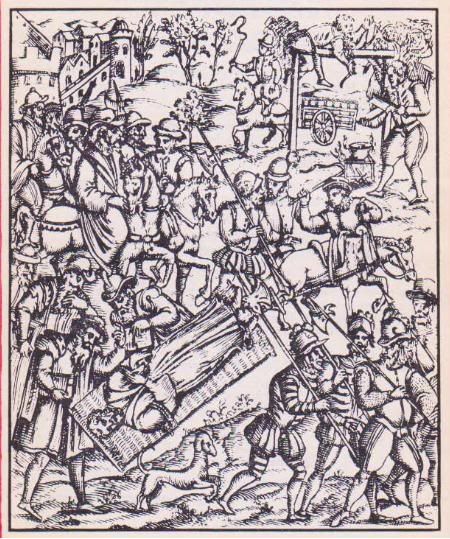 Today marks the feast day and anniversary of the death of the Venerable William Carter (1548-1584). Born in London, William was persecuted for treason against the Queen for his Catholic beliefs, was found guilty, and hanged, drawn, and quartered at the infamous Tyburn gallows.
Today marks the feast day and anniversary of the death of the Venerable William Carter (1548-1584). Born in London, William was persecuted for treason against the Queen for his Catholic beliefs, was found guilty, and hanged, drawn, and quartered at the infamous Tyburn gallows.Through multiple arrests, torture, the death of his family, and near-constant suffering, William Carter refused to renounce his faith or deny his beliefs. He is said to have calmly placed his trust in the Lord, even on the gallows where he made his final confession to a priest being executed beside him.
Are we so sure of our faith? Are we willing to suffer for our beliefs—whether it be mockery, discomfort, or making tough decisions? What are we willing to sacrifice for our faith, our Lord? We look to the Venerable martyr William Carter for inspiration, to never lose faith, to stand boldly, and place our confidence in the Lord. Today we pray for those whose confidence has been shaken. I also will continue my Novena to Our Lady of the Immaculate Conception. Lastly, requested intentions today include those who are preparing for surgery.
Day 11 of 365
Prayer Intentions: Those whose confidence in the Lord has been shaken
Requested Intentions: Those preparing for surgery (L)
Special Intentions: Those trying to conceive or adopt; Those who are pregnant or expecting children; New parents; Those who have experienced miscarriage or pregnancy complications
Today, we celebrate the Baptism of the Lord in the river Jordan by Saint John the Baptist. John the Baptist is my patron (Confirmation) saint, so this is a personally important feast day for me—one which reminds us of humility, of service, to others, and to the saving graces offered to us through rebirth in Christ. The Baptism of the Lord is also the first of the five Luminous Mysteries of the Holy Rosary.
15 And as the people were in expectation, and all men mused in their hearts of John, whether he were the Christ, or not; 16 John answered, saying unto them all, I indeed baptize you with water; but one mightier than I cometh, the latchet of whose shoes I am not worthy to unloose: he shall baptize you with the Holy Ghost and with fire: 17 whose fan is in his hand, and he will thoroughly purge his floor, and will gather the wheat into his garner; but the chaff he will burn with fire unquenchable.
21 Now when all the people were baptized, it came to pass, that Jesus also being baptized, and praying, the heaven was opened, 22 and the Holy Ghost descended in a bodily shape like a dove upon him, and a voice came from heaven, which said, Thou art my beloved Son; in thee I am well pleased. (Luke 3: 15-17; 21-22).
John the Baptist reflected upon his own role in the cosmos, understanding the extraordinary dynamic of conversion preached by Jesus: to make way for the everything that God is, we who are nothing must lose ourselves, become little in order to be great, be the least in order to become the first in Heaven!
But why did Christ need to be baptized? If baptism serves to remove sin, and Christ was sinless, what was the point? In choosing to be baptized by John, Christ models for all Christians the importance of the sacrament, and John models the importance of service and humility. Christ’s baptism further transforms the elements of the world, as St. Maximus of Turn explained in an early homily: “Christ is baptized, not that he may be sanctified in the waters, but that he himself may sanctify the waters, and by his own purification may purify those streams which he touches. For the consecration of Christ is the greater consecration of another element. For when the Savior is washed, then already for our baptism all water is cleansed… Christ therefore takes the lead in baptism, so that Christian peoples may follow after him with confidence.”
The Gospel Liturgy of the “Baptism of the Lord” reminds us of the awesome revelation of the Holy Trinity to all of humanity. As our Lord Jesus Christ—the Son of God made flesh-- was baptized in the waters of the Jordan, the Father’s voice is heard and the Holy Spirit, in the form of a dove, descends. In Greek, baptism is translated as "to be immersed." Through the saving grace and redemption of the Baptism of the Lord, our world is “immersed” in God and, indeed, transformed. Our world, and our lives, will be freed from the snare of sin and reborn, like gold in the refiner's fire !
Today, we pray for those in service to others. We pray for humility and to never lose sight of the central place the Lord should take in our lives.
Of special note, today I will be starting a Novena to Our Lady of the Immaculate Conception. The specific intention for this Novena is for women and couples-- those who I know personally as well as those I do not—who are experiencing difficulties or challenges with conceiving or adopting children. Further, I pray for those who are pregnant or expecting children, new parents, and especially for those who have suffered pregnancy-related loss or complications. May Our Lady of Immaculate Conception look with kindness and blessing upon you, bring you peace and love, and intercede on your behalf with our Lord and Savior, Jesus Christ.
Day 10 of 365
Prayer Intentions: Those in service to others
Special Intentions: Those trying to conceive or adopt; Those who are pregnant or expecting children; New parents; Those who have experienced miscarriage or pregnancy complications
15 And as the people were in expectation, and all men mused in their hearts of John, whether he were the Christ, or not; 16 John answered, saying unto them all, I indeed baptize you with water; but one mightier than I cometh, the latchet of whose shoes I am not worthy to unloose: he shall baptize you with the Holy Ghost and with fire: 17 whose fan is in his hand, and he will thoroughly purge his floor, and will gather the wheat into his garner; but the chaff he will burn with fire unquenchable.
21 Now when all the people were baptized, it came to pass, that Jesus also being baptized, and praying, the heaven was opened, 22 and the Holy Ghost descended in a bodily shape like a dove upon him, and a voice came from heaven, which said, Thou art my beloved Son; in thee I am well pleased. (Luke 3: 15-17; 21-22).
John the Baptist reflected upon his own role in the cosmos, understanding the extraordinary dynamic of conversion preached by Jesus: to make way for the everything that God is, we who are nothing must lose ourselves, become little in order to be great, be the least in order to become the first in Heaven!
But why did Christ need to be baptized? If baptism serves to remove sin, and Christ was sinless, what was the point? In choosing to be baptized by John, Christ models for all Christians the importance of the sacrament, and John models the importance of service and humility. Christ’s baptism further transforms the elements of the world, as St. Maximus of Turn explained in an early homily: “Christ is baptized, not that he may be sanctified in the waters, but that he himself may sanctify the waters, and by his own purification may purify those streams which he touches. For the consecration of Christ is the greater consecration of another element. For when the Savior is washed, then already for our baptism all water is cleansed… Christ therefore takes the lead in baptism, so that Christian peoples may follow after him with confidence.”
The Gospel Liturgy of the “Baptism of the Lord” reminds us of the awesome revelation of the Holy Trinity to all of humanity. As our Lord Jesus Christ—the Son of God made flesh-- was baptized in the waters of the Jordan, the Father’s voice is heard and the Holy Spirit, in the form of a dove, descends. In Greek, baptism is translated as "to be immersed." Through the saving grace and redemption of the Baptism of the Lord, our world is “immersed” in God and, indeed, transformed. Our world, and our lives, will be freed from the snare of sin and reborn, like gold in the refiner's fire !
Today, we pray for those in service to others. We pray for humility and to never lose sight of the central place the Lord should take in our lives.
Of special note, today I will be starting a Novena to Our Lady of the Immaculate Conception. The specific intention for this Novena is for women and couples-- those who I know personally as well as those I do not—who are experiencing difficulties or challenges with conceiving or adopting children. Further, I pray for those who are pregnant or expecting children, new parents, and especially for those who have suffered pregnancy-related loss or complications. May Our Lady of Immaculate Conception look with kindness and blessing upon you, bring you peace and love, and intercede on your behalf with our Lord and Savior, Jesus Christ.
Day 10 of 365
Prayer Intentions: Those in service to others
Special Intentions: Those trying to conceive or adopt; Those who are pregnant or expecting children; New parents; Those who have experienced miscarriage or pregnancy complications
Subscribe to:
Posts (Atom)

